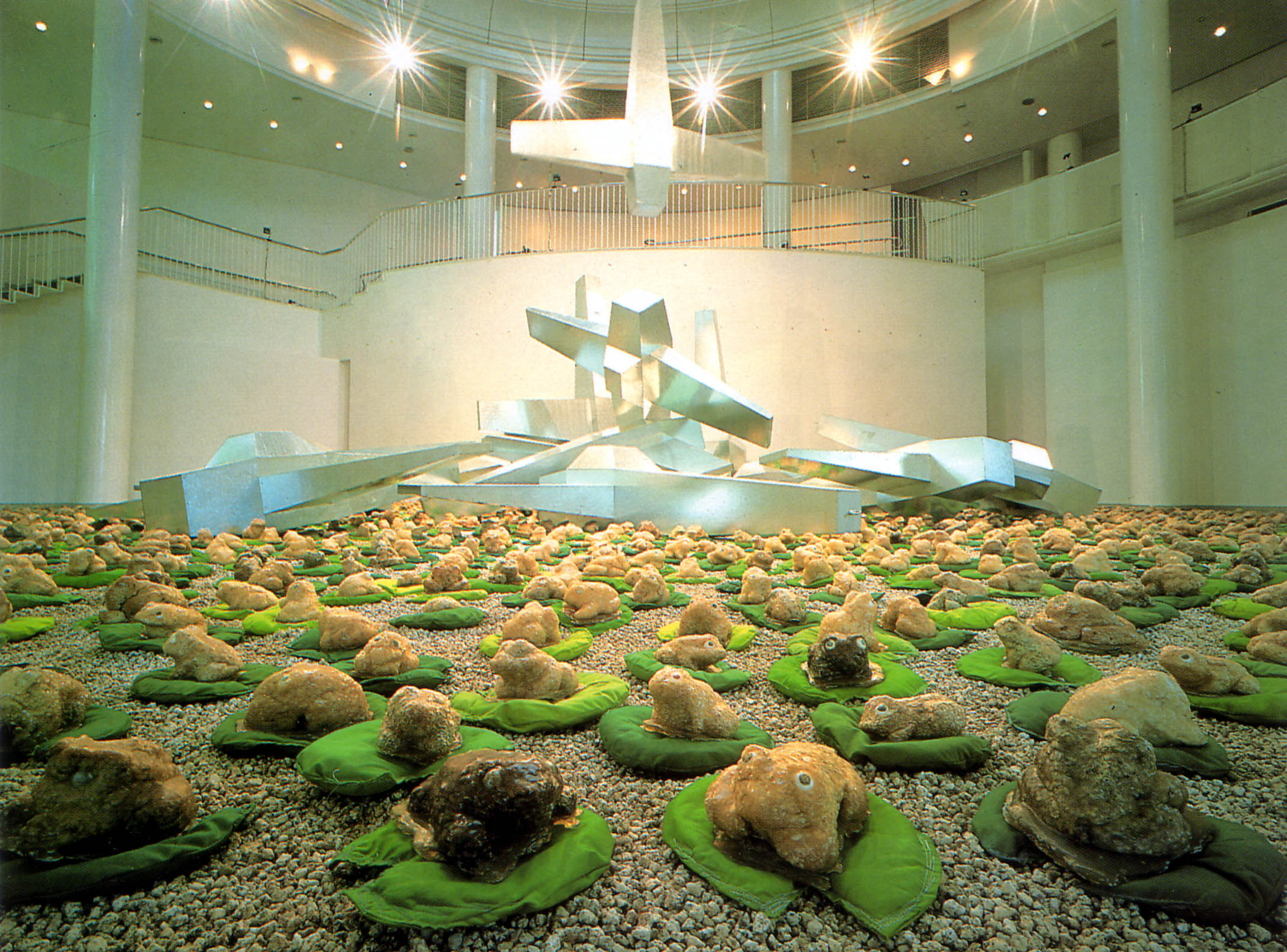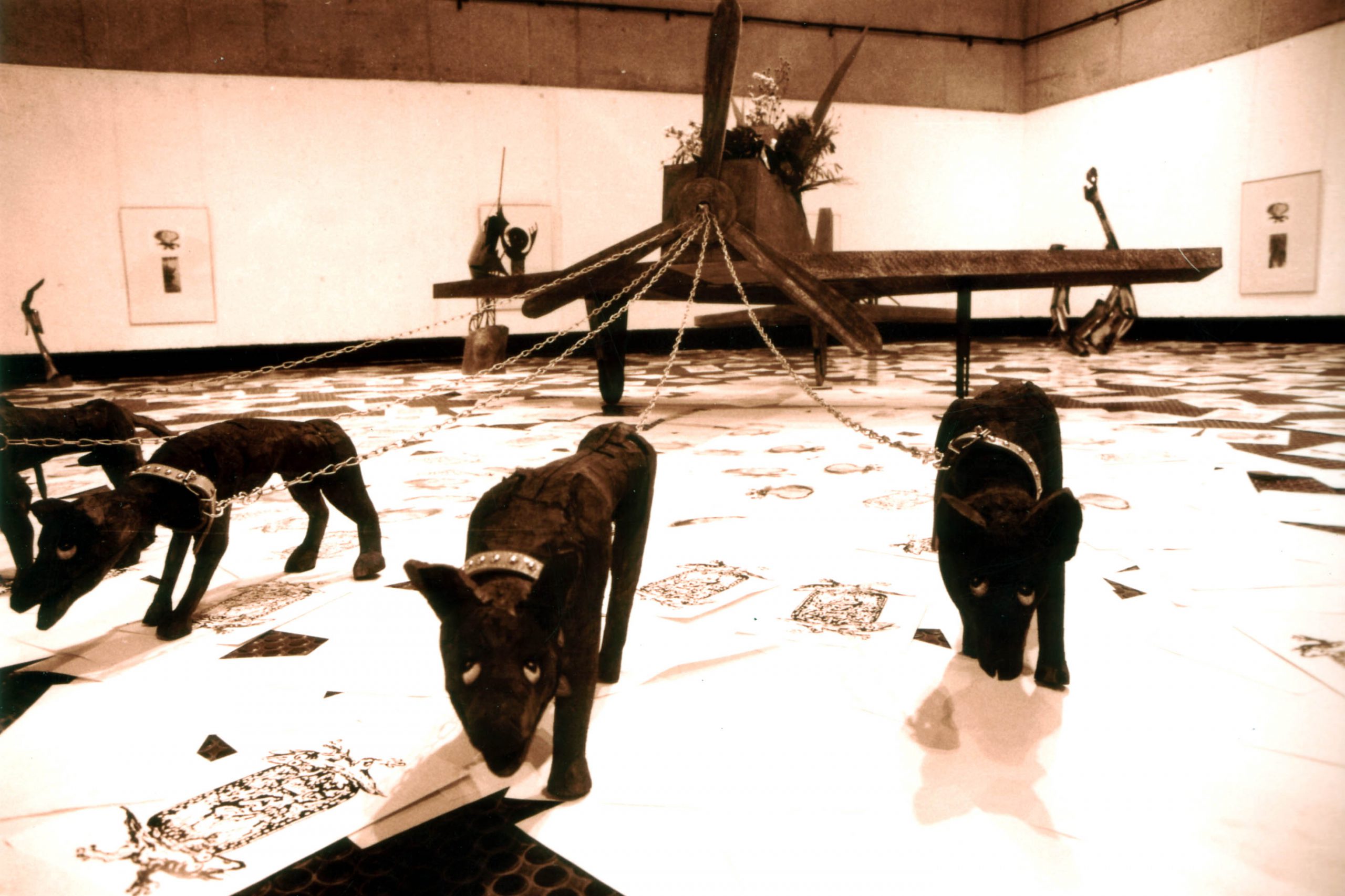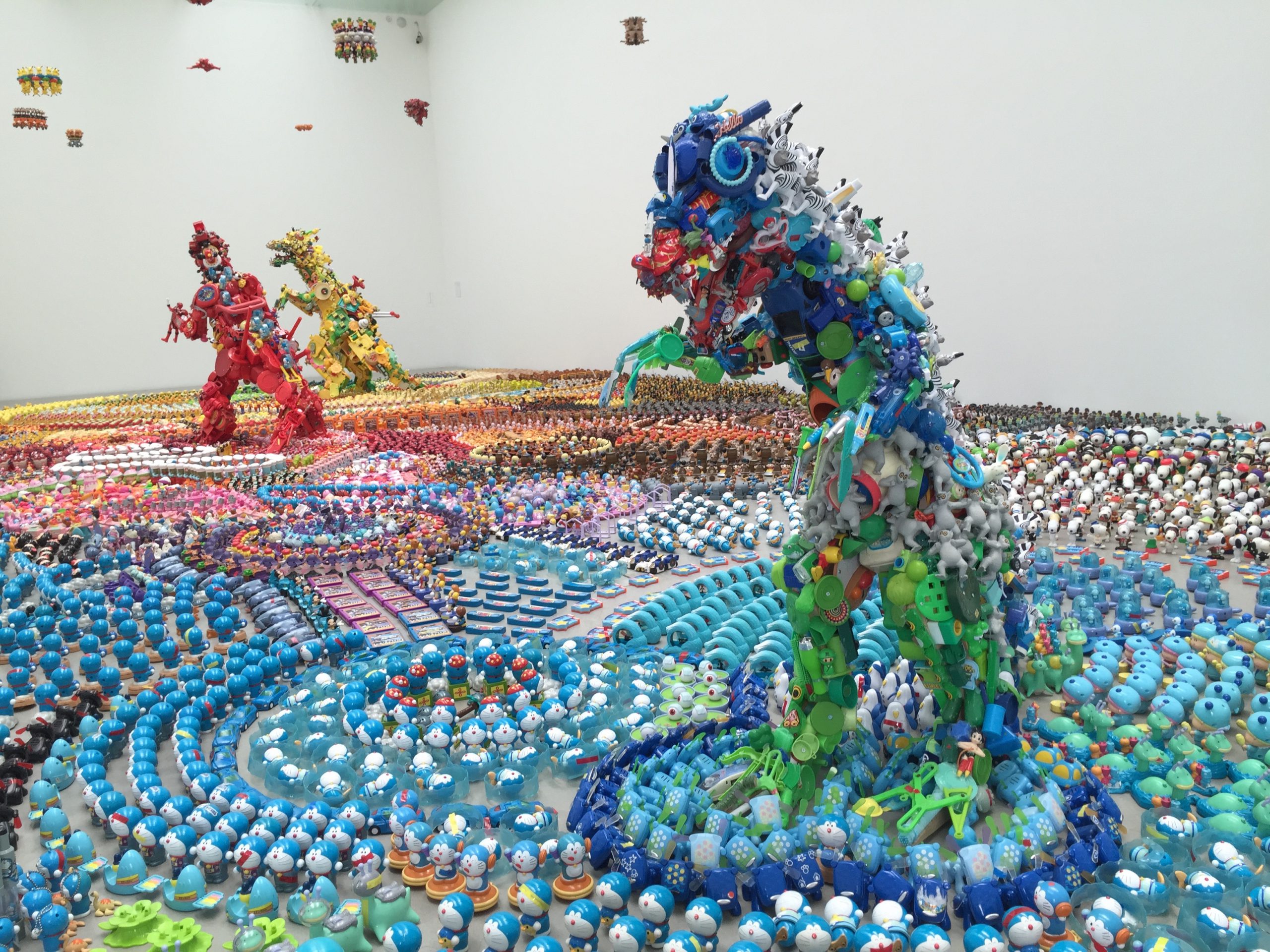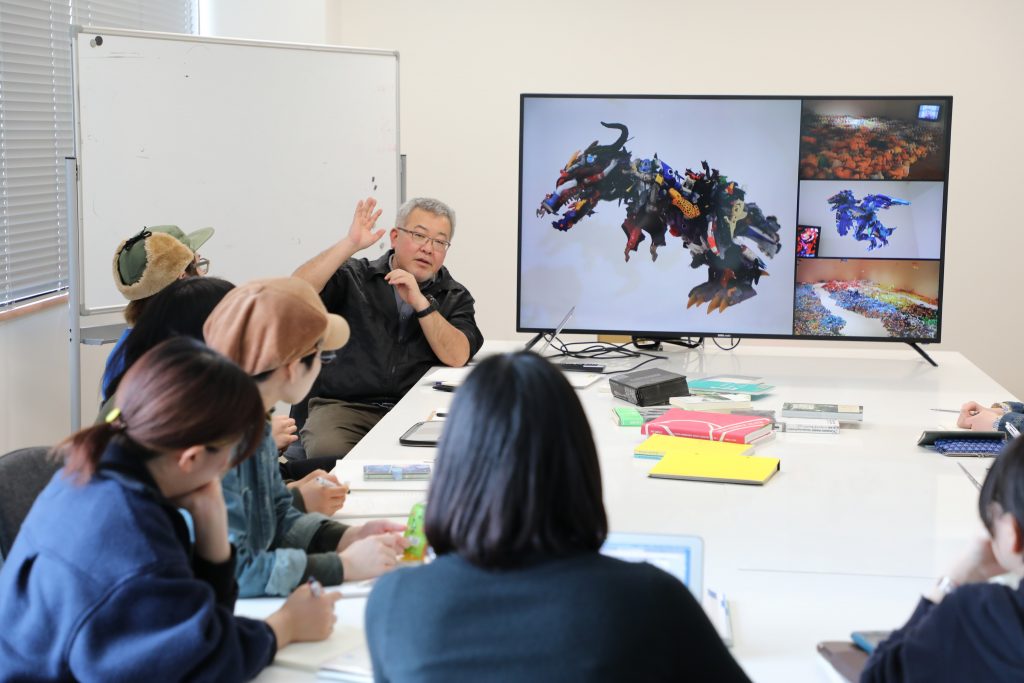HIROSHI FUJI
-

-
- ・Transdisciplinary Arts Theory
- ・Applied Transdisciplinary Arts Theory A
- ・Transdisciplinary Arts Seminar
- ・Transdisciplinary Arts Practicum A
- ・Guided Research I, II (Master’s Program)
- ・Transdisciplinary Arts Research: Expression I, II
- ・Guided Research I, II, III (Doctoral Program)
Profile
Artist / project director
By the time Hiroshi Fuji began his education at Kyoto City University of Arts, he had already amassed a range of interests and experiences as diverse as mathematics, physics, geometry, Japanese painting, pongee weaving, Buddhist imagery and temple architecture. Devoting himself to theatre during his university days, his interest was drawn toward physical expression and the various systems behind it. In graduate school, he founded a group called “Kyoto Information Company,” which used performing-arts techniques such as live shows and street theatre to express anxieties about adulthood and the state of contemporary art. Upon graduation, he taught at the National Arts School of Papua New Guinea as a member of the Japan Overseas Cooperation Volunteers, encountering local art forms and anthropological concepts. Returning to Japan, he worked for redevelopment and urban planning firms in Bunkyo, Tokyo, where he learned about land and city, architecture and law. He then moved from place to place, saving various buildings from demolition by repurposing them as his bases of operation. Eventually settling in Kyushu, he searched for demonstrative forms of expression that combined art with civic action, operating a café which doubled as a public art space and founding “Hiroshi Fuji Planning and Production”. Since the Great East Japan Earthquake of 2011, he has become involved with various cultural and academic institutions in the Tohoku region, developing new projects and connections. Most recently, he was the director of the Towada Art Center in Aomori before obtaining his current position as professor at Akita University of Art, where he teaches in both the Graduate School of Transdisciplinary Arts and the undergraduate Arts & Roots program. He additionally serves as vice chairman of the NPO “+arts,” chairman of the NPO “Arts Center Akita,” director of the Akita City Cultural Creation Center, and president of Fuji Studio Co. (https://www.fujistudio.co)
Research
activities
【Artwork submissions / Artmaking activities】
2018 Nuigurumax. Hajimari Art Center, Inawashiro Town, Fukushima
2018-Present Jurassic Plastic. Sydney, Australia; Kagawa, Japan; Kyoto, Japan; Bangkok, Thailand
2014 Happy Paradies? Ishikawa, Japan; Singapore
2014 Poly planet company. Aomori, Hokkaido, Ibaraki
2012-Present Kaerugumi clubrooms connection. 2nd Water and Land Niigata Art Festival, Niigata City (2012); Chino Cultural Complex, Chino City, Nagano
2010 Fujishima Hachijuro o tsukuru [Make Mr. Hachijuro Fujishima]. 1st Setouchi Triennale. Teshima, Kagawa
2009 Toys Saurus. Aqua Metropolis Osaka; Arts Chiyoda 3331, Tokyo; Roppongi Art Night, Tokyo; etc.
2008-Present Happy forest. Art Tower Mito, Mito City, Ibaraki
2000 Vinyl plastics connection. San Diego Museum of Art, USA; Busan Museum of Art, Korea; Museum of Contemporary Art Taipei, Taiwan; Art Tower Mito, Ibaraki, Japan; ACC Galerie Weimar, Germany; etc.
1998 Kotei wa subrashii [Public places are great]. The former grounds of Gokusho Elementary School, Fukuoka City, Fukuoka
1998 Cycle rickshaw. KHOJ International Workshop 1998. Modinagar, India
1993 Kaeru no kyanpen [Frog campaign]. Takamatsu Art Museum, Kagawa; Kurashiki City Art Museum, Okayama; Fukuyama Museum of Art, Hiroshima; Fukuoka Art Museum, Fukuoka; Setagaya Art Museum, Tokyo; etc.
1991-Present Okome no sabaku, inu no oshikko [Desert of rice, piss of dogs]. Fh Factelier, Tokyo; Gallery Natsuka, Tokyo; Art Tower Mito, Ibaraki; etc.
1991 Bank of Foods. Hara Museum ARC, Gunma
1988-Present Sentoki o hiku yase-inu [Skinny dog]; Yase-inu no sampo [Skinny dog walk]. Papua New Guinea National Museum and Art Gallery, Port Moresby, Papua New Guinea; Tokyo Big Sight; Haizuka Earthworks Project, Hiroshima; Museum City Tenjin, Fukuoka; Contemporary Art Museum Kumamoto; Kitakyushu Municipal Museum of Art; Fukuoka Art Museum; etc.
1985 Soko de gambare amagaeru [So good luck, tree frog]; Kamehaniwa no sumu shima [Island of the ‘Kamehaniwa’]; Matsu no ki no yu’utsu [The pine tree’s depression]. Kyoto Sanjo Shopping Street; Kyoto Avanti; Tama Art University, Tokyo; Yokohama Civic Art Gallery; Hara Museum of Contemporary Art, Tokyo; etc.
1985 Marriage problem of Mr. Godzilla & Ms. Haniwa. Kyoto City KYOCERA Museum of Art (formerly Kyoto Municipal Museum of Art); Tokyo University of the Arts; Kyoto City University of Arts; etc.
1983 Namazu no gunzo kensetsu miteichi [Unutilized land for constructing a bunch of catfish] Vacant land near Lake Teganuma, Chiba
1983 Komyunikeshon dekinai neko [Cats that cannot communicate]. Kawaramachi Street, Kyoto
1983 Kamogawa oyoida koinobori [Carp banners swimming in the Kamo River]. Sanjo Bridge, Kyoto
【Exhibitions / Art Projects】
2020-Present Disukabaryu: Ryu o saguru [Discove’ryu’: Search for dragons]. 35th National Cultural Festival: Miyazaki 2020. Miyakonojo City Museum; Miyakonojo City Library, Miyazaki
2020 Chuta Report. Akita Museum of Modern Art; Omachi Classic, Akita
2019 Shosetsu: Shima Takeshi [The Novel ‘Shima Takeshi’]. Towada Art Center, Aomori
2019 Tottori ginga tetsudo matsuri no butai bijutsu [Set Design of the ‘Milky Way Train Festival in Tottori’]. Torigin Culture Hall, Tottori
2017 Ogunibijuku: Konna kaishaku ari nanda! [Ogunibijuku: You Can Look at It This Way Too!]. Sakamoto Zenzo Museum of Art, Kumamoto
2017-Present Wakeari Zatsugami-bu [Imperfect Paper Trash]. Sendai Mediatheque, Sendai City Environment Bureau, Miyagi
2015 Kirishima cho-geijutsu gakko [Kirishima Super Art School] . Kirishima Open Air Museum, Kagoshima
2014-Present Toizaurusu no hikyo [The Hidden World of ToysSaurus] . Hara Museum ARC, Gunma
2013 Choyaku: Bijutsu no gakko [Super Liberal Art School] (special exhibition). Towada Art Center, Aomori
2012 KAERU Party. Arts Centre Melbourne, Australia
2012 Sentoraru kaeru suteshon [Central Frog Station]. Arts Chiyoda 3331, Tokyo
2011-Present Hiryu: Aomori kara no tabi [Hiryu: A Journey from Aomori]. Aomori Contemporary Art Center; Hakata Station, Fukuoka; Nakanoshima Park, Osaka
2008 Ariosu purantsu! [Alios Plants!]. Alios Iwaki Performing Arts Center, Iwaki City, Fukushima
2008 Kaeru System. 7th SITE Santa Fe International Biennial, Santa Fe, USA
2006 Tennen onsen: Engeki kokyokyoku dai-ichiban [Ten-Year Sound Spring: First Performance Symphony]. Ezuko Hall, Sendai City, Miyagi
2005-Present Iwakan o tobikoeru jutsu [The Art of Overcoming Anxiety]. Fukuoka Art Museum
2000-Present Kaekko. Various locations around the world
1999 Vinyl Plastics Collection. The Hakone Open-Air Museum, Kanagawa
1999 Uta o utau [Sing a Song]. Akihabara Electrical Town Organization, Tokyo
1999 Baku no yume [Dreams of a Tapir]. Art Tower Mito, Ibaraki
1997 Gomi to nezumi to mirai yoso: 2004 nen no Fuji Hiroshi no katsudo o yoso suru gemu [Trash, Mice and Future Forecasting: Game for Predicting Hiroshi Fuji in 2004]. MOMA Contemporary, Fukuoka
1996 Kite Will Cover the Sky. Haizuka Earthworks Project, Hiroshima; National College of Arts, Lahore, Pakistan; etc.
1992 Frog Bar OPEN! Gallery Natsuka, Tokyo
1992 Sayonara kaeru [So Long Frogs]. Ashiya City Museum of Art and History, Hyogo
【Awards / Prizes】
2006 Minister for the Environment’s Prize for Outstanding Contribution Toward a Recycling-Oriented Society (for Kaekko and various related projects). Ministry of the Environment, Government of Japan
2006 Grand Prize (for ‘Dreaming Birds’ and ‘Happy Ring’), 12th Asian Art Biennale Bangladesh 2006. Dhaka Memorial Hall, Bangladesh; He Xiangning Art Museum, Shenzhen, China; 798 Art Zone, Beijing, China; Guangdong Museum of Art, Guangzhou, China; Hirakata City Goten’yama Lifelong Learning Center, Osaka
2000 Kagoshima City Construction and Culture Award (for renovation and management of multipurpose building ‘e-terrace’). Kagoshima City
1997 Local Publishing and Culture Award Runner-up Prize (for picture book ‘Take no hashi’). Tottori Prefecture
1993-1996 Kagoshima City New Artist Award (for ‘Nagare no kansatsu’ [Watching the river]). Kagoshima City Museum of Art; Ogaki City Music Village, Gifu
1992-1993 2nd Japan Art Scholorship Grand Prize Award (for exhibition 2025 Pond of the Frogs Symposium). Aoyama Spiral Hall, Tokyo
1982 Ogo Tomonosuke Award (for ‘Happo-nirami no tatsu modoki [All-seeing pseudo-dragon]’). Kyoto City KYOCERA Museum of Art (formerly Kyoto Municipal Museum of Art)
【Other】
2021- Present Director, Akita City Cultural Creation Center
2017 Stage design, Kisetsu no nai machi [A City Without Seasons]. Unno Yamada Dance Company, Osaka, Japan; Tokyo, Japan; Kuala Lumpur, Malaysia; Sabah, Malaysia
2012 Director, Towada Art Center. Towada City, Aomori
2008 Manager, share studio ‘Kitamoto Tower’. Kitamoto City, Saitama
2006 Manager, share studio ‘Konohana Medias’. Osaka
2005-Present Creator, disaster preparedness program ‘Iza! Kaeru Caravan’. Hyogo; Niigata; Miyazaki; Tokyo; Indonesia; etc.
1999 Member, artist group ‘WochenKlausur’. Museum City Fukuoka
1997 Manager, share studio ‘Studio FARM’. Fukuoka
1989-1996 Manager, café and public art space ‘Media Garden E Space’. Kagoshima
 So long Frogs!
So long Frogs! Skinny dogs
Skinny dogs Toys Saurus
Toys Saurus
